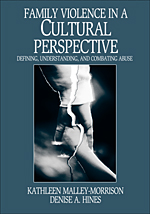
October, 2003 | SAGE Publications, Inc
Family Violence in a Cultural Perspective
Defining, Understanding, and Combating Abuse
Kathleen M. Malley-Morrison - Boston University, USA
Denise A. Hines - George Mason University, Fairfax, VA, USA
328 pages
| October, 2003
| SAGE Publications, Inc
Instant Access!
eBook
ISBN: 9781452266978
Paperback
ISBN: 9780761925965
$135.00
Instant Access!
eBook
ISBN: 9781452266978
"The writing style is engaging and the stories are compelling. Rather than presenting facts and statistics, the authors invite the reader to actively participate in current debates in the family violence research. . . . Family Violence in a Cultural Perspective provides a new, interesting approach."
--Carolyn M. West, University of Washington, Tacoma
"A major achievement in compilation and review, beautifully written. . . .This book accomplishes a necessary and admirable goal of bringing a widely dispersed body of knowledge together."
--Jean Giles-Sims, Texas Christian University
What is maltreatment? How do definitions, causes, consequences, and efforts to combat problems vary across the major ethnic groups within the United States? Family Violence in a Cultural Perspective: Defining, Understanding, and Combating Abuse provides a thought-provoking and informative discussion of cross-cultural issues in family violence in the United States.
The book focuses on family violence from four major ethnic populations of the United States: Native American Indian, African American, Hispanic/Latino, and Asian American. Authors Kathleen Malley-Morrison and Denise A. Hines examine violence in these communities and take an ecological approach to its incidences, correlations, and consequences. The information and cases in Family Violence in a Cultural Perspective are organized within a cognitive-affective-ecological framework, allowing readers to consider the many causes of family violence. The book looks at the different types of family violence including child, spousal, and elder abuse and addresses the broader historical and environmental forces contributing to violence within different communities.
Features and Benefits:
--Carolyn M. West, University of Washington, Tacoma
"A major achievement in compilation and review, beautifully written. . . .This book accomplishes a necessary and admirable goal of bringing a widely dispersed body of knowledge together."
--Jean Giles-Sims, Texas Christian University
What is maltreatment? How do definitions, causes, consequences, and efforts to combat problems vary across the major ethnic groups within the United States? Family Violence in a Cultural Perspective: Defining, Understanding, and Combating Abuse provides a thought-provoking and informative discussion of cross-cultural issues in family violence in the United States.
The book focuses on family violence from four major ethnic populations of the United States: Native American Indian, African American, Hispanic/Latino, and Asian American. Authors Kathleen Malley-Morrison and Denise A. Hines examine violence in these communities and take an ecological approach to its incidences, correlations, and consequences. The information and cases in Family Violence in a Cultural Perspective are organized within a cognitive-affective-ecological framework, allowing readers to consider the many causes of family violence. The book looks at the different types of family violence including child, spousal, and elder abuse and addresses the broader historical and environmental forces contributing to violence within different communities.
Features and Benefits:
- Real family case studies and "Personal Reflections" boxes from members of various ethnic communities covered in the book stimulate class discussion.
- Each chapter contains frequent mini-summaries of the material presented and "thought questions" that help readers reflect upon the difficult issues being addressed.
- The book includes tables summarizing research on the rate of family violence within major ethnic groups and key terms are highlighted within the text.
- Each chapter opens with provocative quotes or examples and closes with a summary section.
Available formats
ISBN: 9781452266978
eBook
Suggested Retail Price: $94.24
Bookstore Price: $75.39
ISBN: 9781452266978
eBook
Suggested Retail Price: $52.00
Bookstore Price: $41.60
ISBN: 9781452266978
eBook
Suggested Retail Price: $58.00
Bookstore Price: $46.40
ISBN: 9781452266978
eBook
Suggested Retail Price: $65.00
Bookstore Price: $52.00
ISBN: 9780761925965
Paperback
Suggested Retail Price: $135.00
Bookstore Price: $108.00
See what’s new to this edition by selecting the Features tab on this page. Should you need additional information or have questions regarding the HEOA information provided for this title, including what is new to this edition, please email sageheoa@sagepub.com. Please include your name, contact information, and the name of the title for which you would like more information. For information on the HEOA, please go to http://ed.gov/policy/highered/leg/hea08/index.html.
For assistance with your order: Please email us at textsales@sagepub.com or connect with your SAGE representative.
SAGE
2455 Teller Road
Thousand Oaks, CA 91320
www.sagepub.com
PART I. FAMILY VIOLENCE IN CULTURAL CONTEXT: BACKGROUND ISSUES
1. Issues and Definitions
2. Theories and Methods
3. Types and Extent of Maltreatment in the United States
PART II. NATIVE AMERICAN INDIAN CULTURES
4. Native American Cultural Contexts
5. Native American Family Violence
PART III. AFRICAN AMERICAN CULTURES
6. African American Cultural Contexts
7. African American Child Maltreatment
8. African American Adult Maltreatment
PART IV. HISPANIC/LATINO CULTURES
9. Hispanic/Latino Cultural Contexts
10. Hispanic/Latino Child Maltreatment
11. Hispanic/Latino Adult Maltreatment
PART V. ASIAN AMERICAN CULTURES
12. Asian American Cultural Contexts
13. Asian American Family Violence
PART VI. CONCLUSION: PREVENTION AND INTERVENTION
14. Prevention and Intervention in Child Maltreatment
15. Prevention and Intervention in Adult Maltreatment
- Written in a Socratic style, the book provides thought-provoking reading by posing questions to students such as, What is maltreatment? How do definitions, causes, consequences, and efforts to combat problems vary across the major ethnic groups within the U.S.?
- Uses actual family case studies with non-essential details changed to protect privacy, as well as "Personal Reflections" boxes from members of various ethnic communities covered in the book. Inclusion of such qualitative material enlivens the texts and provides a basis for class discussions.
- Each chapter contains both frequent mini-summaries of the material being presented and "thought questions" for helping readers reflect upon the difficult issues being addressed.
- Key Terms are highlighted within the text, tables summarize research on rates of family violence within major ethnic groups, and chapters open with provocative quotes or examples and close with conclusion or summary sections.
